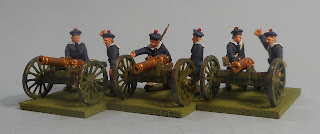And yes, I do know that the Cyrillic R is actually a P, but I couldn't resist using the old movie title.
Over the past several months, I've been experimenting with a new set of rules -- "The Men Would Would Be Kings" from Osprey Publishing. I got 'hooked' on them thanks to Neil of Toy Soldiers and Dining Room Battles blog and his 'Anglo-Russian War' thread, of which this post sets the stage.
I've been a long time Victorian colonial gamer using the late Larry Brom's venerable "The Sword and the Flame Rules." But I've always wanted to do a smaller group of battles around a common theme. So I decided to partially copy Neil's set-up. In my imaginary conflict, the action takes place in the tri-border Russia-Persia (Iran)-Afghanistan area.
My first new unit of this theme was originally owned and painted by the late Dr. Mark "Doc Ord" Stevens. I bought it from his widow after he died from ALS back in 2018. They are a group of Old Glory Russians from their Boxer Rebellion line. I've done some repainting to back date the uniforms somewhat. They will be used as a border guard unit of two 12-figure platoons.
Please click on images for larger pictures.
 |
| Border Guards 1st Platoon |
 |
| Border Guards 2nd Platoon |
"The Men Who Would Be Kings" rules use 12 figures for each regular or irregular infantry unit and 16 figures for a tribal infantry unit. Cavalry are either 8 or 10 figures and guns of any type are manned by 4 figures.
The next unit I painted, this time from the bare metal, is from Askari Miniatures' Russian Colonial line. These figures are dressed in the field uniform popular with Russian units all along the southern arc of the expanding Russian Empire. It consisted of a loose white canvas smock, white canvas trousers, and a Havelock fitted to the kepi. This "Slavic" style uniform was worn from the early 1870s through WW2.
 |
| 8th Siberian Rifles, 1st Platoon, led by the General Skobelev figure |
 |
| 8th Siberian Rifles, 2nd Platoon |
After reorganizing and repainting the Old Glory Russians I obtained from Mark's estate, I had two figures remaining. Since their soft caps looked like some of the ones worn by the figures I've used for a 'Back of Beyond' White Russian unit, I repainted them to match and added them to that unit.
 |
| The two "new" additions are flanking one of the original figures. |
 |
| And the entire White Russian unit. |












































